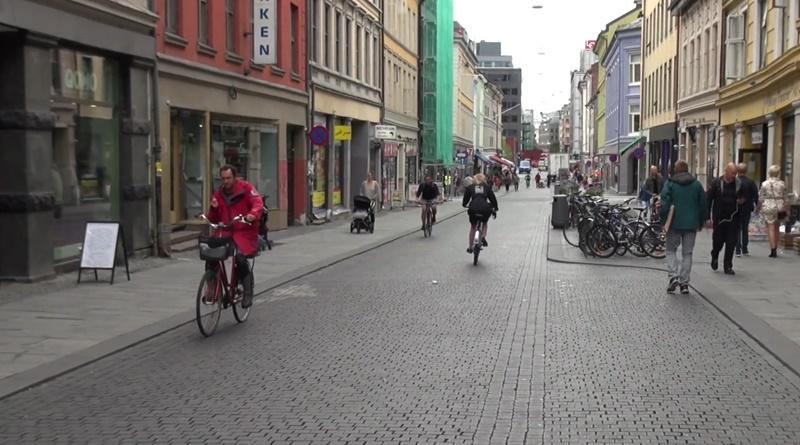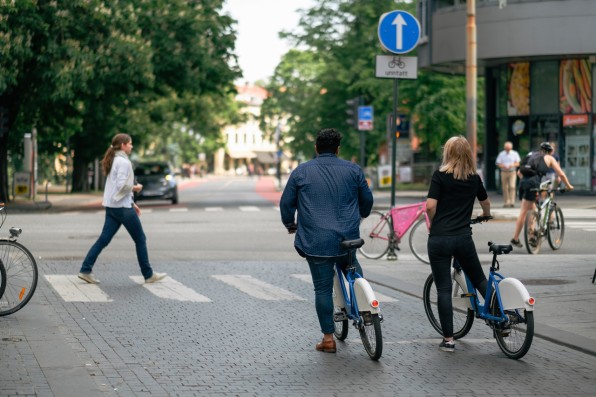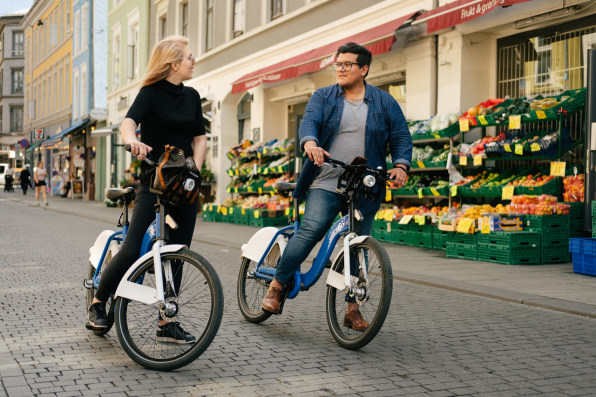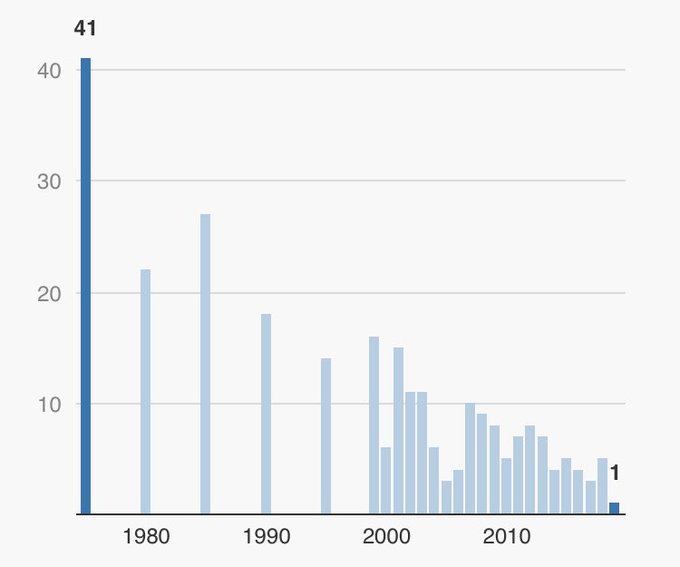-
IP addresses are NOT logged in this forum so there's no point asking. Please note that this forum is full of homophobes, racists, lunatics, schizophrenics & absolute nut jobs with a smattering of geniuses, Chinese chauvinists, Moderate Muslims and last but not least a couple of "know-it-alls" constantly sprouting their dubious wisdom. If you believe that content generated by unsavory characters might cause you offense PLEASE LEAVE NOW! Sammyboy Admin and Staff are not responsible for your hurt feelings should you choose to read any of the content here. The OTHER forum is HERE so please stop asking.
You are using an out of date browser. It may not display this or other websites correctly.
You should upgrade or use an alternative browser.
You should upgrade or use an alternative browser.
Cities going car free to the benefit of ALL!
- Thread starter Leongsam
- Start date
- Joined
- Jul 10, 2008
- Messages
- 66,320
- Points
- 113
How Oslo has all but eliminated cyclist and pedestrian deaths
by Alex Bowden January 4 2020
10 Comments
Norwegian capital removed all car parking from city centre and turned it into bike lanes

Earlier this week, we reported how Oslo recorded zero pedestrian or cyclist fatalities on its roads in 2019. Every serious accident is one too many,” said Ingrid Dahl Hovland, Norway’s top road administrator in response to the news. “The fight against traffic death and serious injuries in traffic continues with unabated strength.”
Oslo, which has a population of about 673,000, has introduced a number of initiatives in recent years as it works towards its Vision Zero goal of eliminating not just all pedestrian and cyclist deaths but also all serious injuries.
2,281 people are talking about this
A city centre car ban was implemented this year, but the city has been gradually working towards this since it was first announced in 2015.
Curbed(link is external) reported how the city increased its congestion charge in 2017 and that move that went hand in hand with the removal of all on-street parking. The recovered space has been used to create more pavements and another 60km of bike lanes.
Clarence Eckerson, who made the film below, was impressed with what he saw when he visited, saying: “We just need to stop providing car parking everywhere, stop requiring it of builders and start removing on-street parking in congested city centres. More parking always means more cars.”
Oslo: The Journey to Car-free(link is external) from STREETFILMS(link is external) on Vimeo(link is external).
Further out in the city, speed limits were reduced and “heart zones” were introduced where motor vehicles are not permitted to pick up or drop off children near primary schools.
In 2017, the proportion of trips taken by bike in Oslo was 8.3%. It is now 16% and the city is aiming for 25% by 2025.
Oslo
Norway
Vision Zero

Alex Bowden
Alex has written for more cricket publications than the rest of the road.cc team combined. Despite the apparent evidence of this picture, he doesn't especially like cake.
10 comments
Oldest firstNewest firstBest rated
Oldest first

burtthebike[3442 posts] 1 day ago
8 likes
We know what the answer to reducing deaths and injuries on the road is, but we ignore it and push helmets. If facts changed people's minds or influenced decision makers we'd live in a very different world.

Simon E[3908 posts] 1 day ago
6 likes

There are a handful of people in a position to make a difference, most visibly Andy Burnham and Chris Boardman in Manchester but they are a tiny minority. Ped- and cyclist-friendly cities like Oslo, Copenhagen and much of the Netherlands are the examples this country should be following.

handlebarcam [1350 posts] 1 day ago
by Alex Bowden January 4 2020
10 Comments
Norwegian capital removed all car parking from city centre and turned it into bike lanes

Earlier this week, we reported how Oslo recorded zero pedestrian or cyclist fatalities on its roads in 2019. Every serious accident is one too many,” said Ingrid Dahl Hovland, Norway’s top road administrator in response to the news. “The fight against traffic death and serious injuries in traffic continues with unabated strength.”
Oslo, which has a population of about 673,000, has introduced a number of initiatives in recent years as it works towards its Vision Zero goal of eliminating not just all pedestrian and cyclist deaths but also all serious injuries.
Anders Hartmann@andershartmann
https://twitter.com/andershartmann/status/1212465415743512576
This makes me happy:
Road deaths in Oslo (pop. 673.000) in 2019:
Pedestrians: 0
Cyclists: 0
Children: 0
The graph shows the reduction of road deaths since 1975.
Article in Norwegian: https://www.aftenposten.no/osloby/i/dO0rzz/1975-41-doede-i-oslo-trafikken-2019-en-doed-i-trafikken …
#VisionZero
4,941
9:07 AM - Jan 2, 2020
Twitter Ads info and privacy
2,281 people are talking about this
A city centre car ban was implemented this year, but the city has been gradually working towards this since it was first announced in 2015.
Curbed(link is external) reported how the city increased its congestion charge in 2017 and that move that went hand in hand with the removal of all on-street parking. The recovered space has been used to create more pavements and another 60km of bike lanes.
Clarence Eckerson, who made the film below, was impressed with what he saw when he visited, saying: “We just need to stop providing car parking everywhere, stop requiring it of builders and start removing on-street parking in congested city centres. More parking always means more cars.”
Oslo: The Journey to Car-free(link is external) from STREETFILMS(link is external) on Vimeo(link is external).
Further out in the city, speed limits were reduced and “heart zones” were introduced where motor vehicles are not permitted to pick up or drop off children near primary schools.
In 2017, the proportion of trips taken by bike in Oslo was 8.3%. It is now 16% and the city is aiming for 25% by 2025.
Oslo
Norway
Vision Zero
Alex Bowden
Alex has written for more cricket publications than the rest of the road.cc team combined. Despite the apparent evidence of this picture, he doesn't especially like cake.
10 comments
Oldest firstNewest firstBest rated
Oldest first

burtthebike[3442 posts] 1 day ago
8 likes
We know what the answer to reducing deaths and injuries on the road is, but we ignore it and push helmets. If facts changed people's minds or influenced decision makers we'd live in a very different world.

Simon E[3908 posts] 1 day ago
6 likes
By 'we' I guess you mean so-called road safety orgs that are puppets working to further the interests of drivers or vehicle manufacturers. They are the ones preserving the status quo, selling the fantasy of 'freedom' of cars (and helmets for cyclists). They don't give a f**k about anyone else, whether it's acute issues like NMOTD and the dreadful casualty statistics we read about every year to the chronic suffering of anyone who lives, works or even breathes next to a busy road. Because anyone with that perspective would get roasted alive on here. I'd be up for that.burtthebike wrote:
We know what the answer to reducing deaths and injuries on the road is, but we ignore it and push helmets. If facts changed people's minds or influenced decision makers we'd live in a very different world.

There are a handful of people in a position to make a difference, most visibly Andy Burnham and Chris Boardman in Manchester but they are a tiny minority. Ped- and cyclist-friendly cities like Oslo, Copenhagen and much of the Netherlands are the examples this country should be following.
(some useful links in that twitter thread BTW)Quote:
The Dutch cycle 15 billion km every year, which saves their healthcare system €19 billion. They've achieved this by doubling the size of their bike network since 1996, and they now spend €595 million annually on cycling, or €35 per resident. In England we spend £7 per person.
https://twitter.com/anotherJon/status/1213367316571971586(link is external)

handlebarcam [1350 posts] 1 day ago
- Joined
- Oct 7, 2012
- Messages
- 5,228
- Points
- 113
What is wrong with cars? Pedal power is better than simply walking but it is not powerful enough for some tasks. Revert back to horse power? Then, your cities will be filled with horse shit!
https://www.historic-uk.com/HistoryUK/HistoryofBritain/Great-Horse-Manure-Crisis-of-1894/
The answer is to make better cars - self-driving and fueled by non-polluting renewable energy. And all those fuckers who don't know how to look left and right before crossing the road, they deserve to be dead anyway.
https://www.historic-uk.com/HistoryUK/HistoryofBritain/Great-Horse-Manure-Crisis-of-1894/
The answer is to make better cars - self-driving and fueled by non-polluting renewable energy. And all those fuckers who don't know how to look left and right before crossing the road, they deserve to be dead anyway.
- Joined
- Jul 10, 2008
- Messages
- 66,320
- Points
- 113
[*]01-24-19
[*]WORLD CHANGING IDEAS
What happened when Oslo decided to make its downtown basically car-free?
It was a huge success: Parking spots are now bike lanes, transit is fast and easy, and the streets (and local businesses) are full of people.
[Photo: Åsmund Holien Mo/Urban Sharing]
BY ADELE PETERS5 MINUTE READ
If you decide to drive in downtown Oslo, be forewarned: You won’t be able to park on the street. By the beginning of this year, the city finished removing more than 700 parking spots–replacing them with bike lanes, plants, tiny parks, and benches–as a major step toward a vision of a car-free city center.
ADVERTISEMENT
Without those parking spots, and with cars banned completely on some streets, few people are driving in the area. “There are basically no cars,” says Axel Bentsen, CEO of Urban Sharing, the company that runs Oslo City Bike, the local bike-share system. The city’s changes are designed, in part, to help improve air quality and fight climate change, but the difference in the quality of life is more immediate. “The city feels different faster than you can feel the difference in [cleaner air],” he says. “You can see that you’re actually reclaiming the space and can use it for other purposes than parking cars.”
Oslo first pedestrianized some streets in the city center in the 1970s, and invested heavily in public transportation in the 1980s. In 2015, when a progressive political coalition came to power in the city council, they started planning a more significant transformation. At first, they called for a full ban on cars because the majority of residents in the city center didn’t drive. But when business owners objected, worried that they’d lose customers and have problems with deliveries, the government changed focus to remove parking spots–a slightly more gradual approach. For now, there are still parking garages on the periphery of the center.

Photo: Åsmund Holien Mo/Urban Sharing]A few spots are left, converted into parking for disabled drivers or EV charging, and some streets are open for delivery trucks for a couple of hours in the morning. Emergency vehicles still have access. But other drivers have to park in garages, and traffic restrictions help nudge drivers who don’t need to go through the city center to take a ring road around it instead. In a new zoning plan, the city is taking its intentions further, giving pedestrians, cyclists, and public transportation greater priority than private cars, and planning a network of pedestrian zones that are fully car-free.
“Cities, like Oslo, have been built for cars for several decades, and it’s about time we change it,” Hanne Marcussen, Oslo’s vice mayor of urban development, said in an email. “I think it is important that we all think about what kind of cities we want to live in. I am certain that when people imagine their ideal city, it would not be a dream of polluted air, cars jammed in endless traffic, or streets filled up with parked cars.”
To help support the shift, the city made “massive improvements in public transport and making cycling safe and comfortable,” says Rune Gjøs, Oslo’s head of cycling. The city is adding new trams and metro lines and more frequent departures, and lowering the cost of tickets. For the last few years, the city has also been quickly building out a better-connected bike network, converting parking to bright-red bike lanes. It handed out grants to help citizens buy electric bikes. The city bike-share system has quickly grown, tripling to nearly 3 million trips a year between 2015 and 2018. The system usually closes in the winter, but it ran a pilot this winter using bikes with spiked tires. It also tested offering cargo bikes.

[Photo: Åsmund Holien Mo/Urban Sharing]
As more people bike, that opens up room on overcrowded public transit. “Usually when you have these discussions you say, ‘Oh, we need bikes to replace cars,’ but there’s a missing link there, and that’s public transit,” says Bentsen. “What we see is that actually we take people out of the bus and onto the bike and walking, which leaves room for people to leave their car and take the bus.”
[*]WORLD CHANGING IDEAS
What happened when Oslo decided to make its downtown basically car-free?
It was a huge success: Parking spots are now bike lanes, transit is fast and easy, and the streets (and local businesses) are full of people.
[Photo: Åsmund Holien Mo/Urban Sharing]
BY ADELE PETERS5 MINUTE READ
If you decide to drive in downtown Oslo, be forewarned: You won’t be able to park on the street. By the beginning of this year, the city finished removing more than 700 parking spots–replacing them with bike lanes, plants, tiny parks, and benches–as a major step toward a vision of a car-free city center.
ADVERTISEMENT
Without those parking spots, and with cars banned completely on some streets, few people are driving in the area. “There are basically no cars,” says Axel Bentsen, CEO of Urban Sharing, the company that runs Oslo City Bike, the local bike-share system. The city’s changes are designed, in part, to help improve air quality and fight climate change, but the difference in the quality of life is more immediate. “The city feels different faster than you can feel the difference in [cleaner air],” he says. “You can see that you’re actually reclaiming the space and can use it for other purposes than parking cars.”
Oslo first pedestrianized some streets in the city center in the 1970s, and invested heavily in public transportation in the 1980s. In 2015, when a progressive political coalition came to power in the city council, they started planning a more significant transformation. At first, they called for a full ban on cars because the majority of residents in the city center didn’t drive. But when business owners objected, worried that they’d lose customers and have problems with deliveries, the government changed focus to remove parking spots–a slightly more gradual approach. For now, there are still parking garages on the periphery of the center.

Photo: Åsmund Holien Mo/Urban Sharing]A few spots are left, converted into parking for disabled drivers or EV charging, and some streets are open for delivery trucks for a couple of hours in the morning. Emergency vehicles still have access. But other drivers have to park in garages, and traffic restrictions help nudge drivers who don’t need to go through the city center to take a ring road around it instead. In a new zoning plan, the city is taking its intentions further, giving pedestrians, cyclists, and public transportation greater priority than private cars, and planning a network of pedestrian zones that are fully car-free.
“Cities, like Oslo, have been built for cars for several decades, and it’s about time we change it,” Hanne Marcussen, Oslo’s vice mayor of urban development, said in an email. “I think it is important that we all think about what kind of cities we want to live in. I am certain that when people imagine their ideal city, it would not be a dream of polluted air, cars jammed in endless traffic, or streets filled up with parked cars.”
To help support the shift, the city made “massive improvements in public transport and making cycling safe and comfortable,” says Rune Gjøs, Oslo’s head of cycling. The city is adding new trams and metro lines and more frequent departures, and lowering the cost of tickets. For the last few years, the city has also been quickly building out a better-connected bike network, converting parking to bright-red bike lanes. It handed out grants to help citizens buy electric bikes. The city bike-share system has quickly grown, tripling to nearly 3 million trips a year between 2015 and 2018. The system usually closes in the winter, but it ran a pilot this winter using bikes with spiked tires. It also tested offering cargo bikes.

[Photo: Åsmund Holien Mo/Urban Sharing]
As more people bike, that opens up room on overcrowded public transit. “Usually when you have these discussions you say, ‘Oh, we need bikes to replace cars,’ but there’s a missing link there, and that’s public transit,” says Bentsen. “What we see is that actually we take people out of the bus and onto the bike and walking, which leaves room for people to leave their car and take the bus.”
- Joined
- Aug 10, 2008
- Messages
- 110,680
- Points
- 113
Without those parking spots, and with cars banned completely on some streets, few people are driving in the area. “There are basically no cars,” says Axel Bentsen, CEO of Urban Sharing, the company that runs Oslo City Bike, the local bike-share system. The city’s changes are designed, in part, to help improve air quality and fight climate change
Not that nonsense again. Humans are just a speck in the cosmos of time. You're not going to change anything with human efforts.

- Joined
- Sep 22, 2008
- Messages
- 89,340
- Points
- 113
Oslo and new zealand are ok to ride bikes. But its not ok in sinkieland due to heat and humidity.
- Joined
- Feb 4, 2016
- Messages
- 2,268
- Points
- 113
The most important factor is the weather, it is cooling at Norway, nice to bike around. But in SG ... i wonder how the majority will travel to work on bike, sweating. But another important in this video our Govt must learn, is they built bike lane first ... then encourage their people to switch over, unlike act blur SG, encourage share footpath
Similar threads
- Replies
- 20
- Views
- 1K
- Replies
- 4
- Views
- 302
- Replies
- 8
- Views
- 359
- Replies
- 4
- Views
- 279


